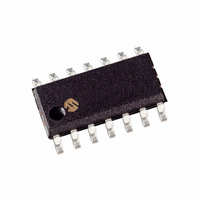HCS473T/SL Microchip Technology, HCS473T/SL Datasheet - Page 42

HCS473T/SL
Manufacturer Part Number
HCS473T/SL
Description
IC KEELOQ 3AXIS TRANSCODR 14SOIC
Manufacturer
Microchip Technology
Series
KEELOQ®r
Type
Code Hopping Encoder and Transponderr
Specifications of HCS473T/SL
Applications
Access Control Systems
Mounting Type
Surface Mount
Package / Case
14-SOIC (3.9mm Width), 14-SOL
Lead Free Status / RoHS Status
Lead free / RoHS Compliant
HCS473
FIGURE 5-2:
5.3
The
synchronization technique (Figure 5-3) which does not
require the calculation and storage of future codes. If
the stored counter value for that particular transmitter
and the counter value that was just decrypted are
within a window of 16 codes, the counter is stored and
the command is executed. If the counter value was not
within the single operation window, but is within the
double operation window of 32K codes (when using a
16-bit counter), the transmitted synchronization value
is stored in temporary location and it goes back to wait-
ing for another transmission.
When the next valid transmission is received, it will
check the new value with the one in temporary storage.
If the two values are sequential, it is assumed that the
DS40035C-page 40
No
No
No
No
No
technology
Decrypt Transmission
Synchronization with Decoder
in Temp Location
Serial Number
Save Counter
Transmission
Decryption
Within 32K
Within 16
Received
Counter
Counter
Match
Start
Does
Valid
Is
Is
?
?
Is
?
?
?
No
Yes
Yes
Yes
Yes
TYPICAL DECODER
OPERATION
features
Yes
a
Command
Execute
Counter
Update
and
sophisticated
Preliminary
counter had just gotten out of the single operation ‘win-
dow’. Since it is now back in sync, the new synchroni-
zation value is stored and the command executed.
If a transmitter has somehow gotten out of the double
operation window, the transmitter will not work and
must be relearned. Since the entire window rotates
after each valid transmission, codes that have been
used are part of the ‘blocked’ (32K) codes and are no
longer valid. This eliminates the possibility of grabbing
a previous code and retransmitting to gain entry.
FIGURE 5-3:
5.4
Communication between a base station and a HCS473
transponder occurs via magnetic coupling between the
transponder coil and base station coil. The base station
coil forms part of a series RLC circuit. The base station
communicates to the transponder by switching the 125
kHz signal to the series RLC circuit on and off. Thus,
the base station magnetic field is switched on and off.
The transponder coil is connected in parallel with a res-
onating capacitor (125 kHz) and the HCS473.
When the transponder is brought into the base station
magnetic field, it magnetically couples with this field
and draws energy from it. This loading effect can be
observed as a decrease in voltage across the base sta-
tion resonating capacitor. The K
communicates to the base station by “shorting out” its
parallel LC circuit. This detunes the transponder and
removes the load, which is observed as an increase in
voltage across the base station resonating capacitor.
The base station capacitor voltage is the input to the
base station AM demodulator circuit. The demodulator
extracts the transponder data for further processing by
the base station software.
Note:
Entire Window
rotates to eliminate
use of previously
used codes
Inductive Communication
The synchronization method described in
this section is only a typical implementation
and because it is usually implemented in
firmware, it can be altered to fit the needs
of a particular system
Double
Operation
(32K Codes)
(32K Codes)
Blocked
SYNCHRONIZATION
WINDOW (16-BIT
COUNTER)
2002 Microchip Technology Inc.
Single Operation
Window (16 Codes)
EE
L
OQ
Current
Position
transponder














